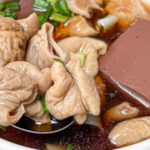How to Choose and Cook Delicious Pork Intestines
To prepare mouth-watering, crispy pork intestines, you must first select the best sections. The ideal choice would be to opt for curled and twisted sections as they offer a delightful crunchy texture.
When making your selection, pay attention to the color of the intestines and test their elasticity. Choose intestines that are firm and not mushy, as these indicate freshness and quality.
Additionally, use your sense of smell to assess the intestines. Avoid any with an unusual odor, but keep in mind that fresh intestines do have a distinct aroma, which is normal.

The Art of Boiling Pork Intestines
A Step-by-Step Guide to Cooking Tender and Crispy Pork Intestines
Step 1: Prepare the Intestines
Start by cutting the pork intestines into smaller sections, approximately 30-35 cm in length. This helps ensure thorough cleaning and even cooking. Place the intestines in a bowl and add two tablespoons of vinegar and one tablespoon of salt. Gently massage the intestines to release some of their juices, as this will enhance their flavor and cleanliness. Avoid over-scrubbing or scraping the intestines, as it may make them tough. Rinse the intestines afterward.
Next, place the intestines in a bowl and squeeze in the juice of one lemon. Add a few slices of crushed ginger and let them soak for 15-20 minutes to further enhance their flavor and freshness. Alternatively, you can blanch the intestines in boiling water for 15 seconds and gently pat them dry to remove excess moisture.
Step 2: Boil the Intestines
Prepare a pot of boiling water with crushed lemongrass and ginger. Add the intestines and use chopsticks to submerge them. Boil for approximately 1.5 minutes. During this process, prepare a bowl of cold water with ice cubes and lemon juice to enhance the flavor and texture of the intestines.

The Secret to Delicious Boiled Intestines
Step 3: Control the Cooking Process
Place the pot of boiling water with the intestines on the stove and bring it to a rolling boil. After two minutes, remove the intestines and immediately immerse them in the prepared bowl of iced water for about a minute to halt the cooking process. This step helps maintain their crispiness, while the lemon juice ensures they remain white and fragrant.
Step 4: Repeat the Boiling Process
Bring the pot of water back to a boil and add the intestines for a second time. Boil for approximately one minute on high heat. Remove the intestines and once again immerse them in the iced water. Finally, remove the intestines from the water, cut them into bite-sized pieces (about 5 cm each), and arrange them on a serving plate.
Step 5: Serve with Condiments and Dipping Sauce
Accompany the boiled intestines with fresh herbs and vegetables. Prepare a dipping sauce by mixing fish sauce with chili and a dash of lemon juice for a perfect flavor combination.
Delicious and Authentic Recipe for Ho Ngoc Hoa-style Hủ Tiếu Noodles
Take a journey into the world of Ho Tieu Ho, a popular Chinese dish known for its alluring and distinctive flavors. In this article, we will delve into the art of crafting this delectable delicacy and discover the secrets behind its tantalizing aroma. Join us as we explore the intricacies of creating the perfect Ho Tieu Ho and unlock the magic of this culinary masterpiece.
































